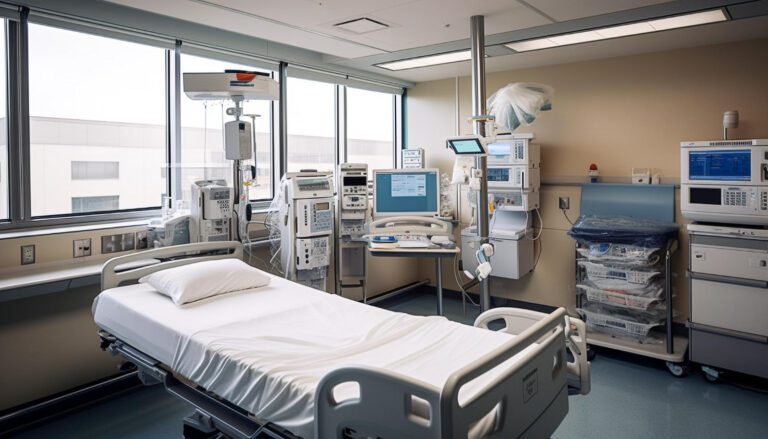
Did you know that effective hospital design planning for medical facilities can have a profound impact on patient care and staff efficiency in healthcare institutions?
Hospital architecture plays a crucial role in creating an environment that promotes healing, enhances productivity, and improves the overall patient experience in healthcare institutions and medical facilities. From the configuration of the interior spaces in healthcare institutions to the architectural elements and construction materials used in hospital buildings, every aspect of hospital design is carefully considered to ensure optimal functionality and comfort for each department.
Studies have shown that well-designed hospital buildings can lead to reduced medical errors, shorter patient stays, and improved staff satisfaction. The U.S. Department of Health recommends that caregivers prioritize the design and layout of hospitals to ensure optimal outcomes for patients and staff.
In fact, research from Google Scholar has revealed that patients in well-designed hospitals, as determined by the department’s configuration, have lower stress levels, experience faster recoveries, and are more likely to recommend the facility to others.
Moreover, hospital design also takes into account the configuration of the building, infection control measures, and accessibility for patients with disabilities. Additionally, researchers in the medical field often use tools like Google and the medical literature to gather data about hospital design.
Table of Contents
- 0.1 Who designs hospitals?
- 0.2 Understanding Hospital Planning, Design, and Codes
- 0.3 Creating a Pleasant Clinical Environment
- 0.4 Technology Planning for Hospitals
- 0.5 key points to consider when integrating technology systems include:
- 0.6 Flexibility and Expandability in Hospital Design
- 0.7 Design Standards and Relevant Codes for
- 0.8 Strategies for Achieving Fire Safety in Healthcare Settings
- 0.8.1 Implementing a Comprehensive Fire Safety Plan
- 0.8.2 Regular Staff Training on Fire Prevention and Response Procedures
- 0.8.3 Conducting Thorough Risk Assessments
- 0.8.4 Maintaining Clear Evacuation Routes and Practicing Emergency Drills
- 0.8.5 Emphasizing Barrier Management Processes
- 0.8.6 importance of optimizing workflows and minimizing travel distances
- 0.8.7 Strategies to reduce construction costs without compromising quality
- 0.8.8 Incorporating sustainable design practices to minimize operational expenses
- 0.9 Conclusion
- 0.10 Frequently Asked Questions
- 0.10.1 What role does technology play in hospital design planning?
- 0.10.2 How important is flexibility in hospital design?
- 0.10.3 What are some key design standards and codes for healthcare facilities?
- 0.10.4 How can a pleasant clinical environment impact patient outcomes?
- 0.10.5 What are the key principles for hospital design and technology planning?
- 1 Subscribe to our Newsletter
Who designs hospitals?
Designing hospitals is a complex task that requires the expertise of professionals from various fields, including the departments of architecture, engineering, and healthcare. The critical nature of this task is evident in the need for collaboration between these different departments to ensure the successful completion of hospital projects.
Additionally, the use of healthcare resources can provide valuable research and information to support the design process. Let’s take a closer look at the key players involved in the design process, who provide valuable research insights, and the hospital construction industry, which plays a crucial role in building healthcare facilities.
-
- Architects: Architects play a crucial role in hospital design. They are responsible for creating the overall layout and structure of the hospital construction, ensuring that it meets the functional needs of a healthcare facility. When designing spaces like patient rooms, operating theaters, and waiting areas, they carefully consider factors such as patient flow, accessibility, and safety.
-
- Engineers, including structural, electrical, mechanical, and plumbing engineers, contribute their technical expertise to hospital design. They ensure that the building’s infrastructure is sound, that the electrical and mechanical systems are reliable, and that the plumbing systems meet the specific needs of a healthcare environment.
-
- Interior Designers: Interior designers focus on creating a welcoming and functional environment within the hospital. They select materials, colors, and furnishings that promote healing and comfort for patients while also considering the practical needs of healthcare professionals.
-
- Medical Professionals: Medical professionals, such as doctors and nurses, provide valuable input during the design process. Their knowledge and experience help ensure that the hospital’s layout and design support efficient workflows, patient safety, and the delivery of high-quality care.
-
- Facility Managers: Facility managers are involved in the design process to ensure that the hospital’s infrastructure and systems can be effectively maintained and operated. They consider factors such as energy efficiency, maintenance requirements, and the longevity of equipment when making design decisions.
While these professionals are the primary designers of hospitals, it’s important to note that the design process often involves collaboration and input from various stakeholders, including hospital administrators, patients, and community members. This multidisciplinary approach helps create hospitals that meet the diverse needs of patients, healthcare providers, and the community as a whole.
Understanding Hospital Planning, Design, and Codes
Hospital planning and design go hand in hand with building codes to create safe and functional healthcare facilities. Compliance with health and safety regulations is crucial in hospital design to ensure the well-being of patients, staff, and visitors.
Hospital planning involves a comprehensive approach to creating a facility that meets the unique needs of patients and healthcare providers. It encompasses various aspects such as layout, functionality, equipment placement, and aesthetics. Designing a hospital involves translating these plans into physical structures that are efficient, accessible, and conducive to healing.
Building codes play a vital role in hospital design by providing construction guidelines that prioritize safety standards. These codes outline requirements for fire safety measures, electrical systems, plumbing, ventilation, emergency exits, and more. By adhering to these codes during the design phase of a hospital project, architects and engineers can ensure that the facility meets all necessary safety standards.
Compliance with health and safety regulations in hospital design
Healthcare facilities must comply with stringent health and safety regulations to safeguard patients’ well-being. Hospital design must consider infection control measures to prevent the spread of diseases within the facility. This includes proper ventilation systems to maintain air quality and reduce the risk of airborne pathogens.
In addition to infection control measures, hospitals must also adhere to regulations concerning patient privacy (such as HIPAA compliance), accessibility for individuals with disabilities (as per ADA guidelines), sanitation protocols (including waste management), emergency preparedness (such as disaster response plans), and more.
Considerations of accessibility and universal design principles in hospitals
Accessibility is a crucial aspect of hospital design. Hospitals should be designed to accommodate individuals with disabilities or mobility limitations effectively. Incorporating universal design principles ensures that everyone can access facilities without facing unnecessary barriers.
Some considerations for accessibility include ramps and elevators for wheelchair users or those with limited mobility, wide corridors for easy navigation, accessible restrooms with appropriate fixtures, and tactile signage for individuals with visual impairments. By incorporating these features, hospitals can provide equal access to healthcare services for all.
importance of zoning regulations in hospital planning
Zoning regulations play a significant role in hospital planning by dictating where healthcare facilities can be located and what activities can take place within those areas. These regulations aim to ensure that hospitals are appropriately situated, considering factors such as proximity to residential areas, traffic flow, noise levels, and environmental impact.
Creating a Pleasant Clinical Environment
A pleasant clinical environment is crucial for promoting healing and ensuring patient safety. In hospital design planning, several factors contribute to creating such an environment. Let’s explore some of these factors and strategies that can be implemented.
Natural Light and Green Spaces
One way to enhance the clinical environment is by incorporating natural light and green spaces into the hospital design. Natural light has been shown to have numerous benefits, including improving mood, reducing stress levels, and enhancing overall well-being. By strategically placing windows in patient rooms and common areas, hospitals can maximize the amount of natural light that enters the space.
Green spaces, such as gardens or outdoor seating areas, connect patients to nature and offer a peaceful retreat where they can relax and recover. These green spaces not only benefit patients but also provide a calming atmosphere for healthcare professionals, helping them recharge during their breaks.
Reducing Noise Levels
Noise levels in healthcare facilities can be overwhelming for both patients and caregivers. Excessive noise can disrupt sleep patterns, increase stress levels, and hinder the healing process. To address this issue, hospitals should implement strategies to reduce noise levels.
Some effective approaches include using sound-absorbing materials on floors, walls, and ceilings to minimize echoes, installing acoustic panels in high-traffic areas, implementing quiet zones where noise is strictly controlled, and utilizing white noise machines or soothing music in patient rooms to mask disruptive sounds.
The Importance of Ergonomic Designs
Ergonomic design plays a vital role in creating a pleasant clinical environment for healthcare professionals. These designs focus on optimizing workspaces to reduce physical strain on caregivers while ensuring efficient workflow.
By providing ergonomic furniture, adjustable equipment heights, proper lighting conditions, and easy access to necessary supplies within arm’s reach, hospitals can help prevent musculoskeletal injuries among healthcare professionals. This not only promotes their well-being but also enhances patient care by enabling caregivers to perform their duties comfortably and effectively.
Incorporating these ergonomic designs into hospitals benefits the staff and sends a message to patients that their caregivers are valued and well-supported.
Creating a pleasant clinical environment is essential for improving the patient experience, promoting healing, and ensuring the well-being of healthcare professionals. By incorporating natural light and green spaces, reducing noise levels, and implementing ergonomic designs, hospitals can create an atmosphere conducive to healing and wellness.
Remember, hospital design planning should always prioritize patient needs, caregiver comfort, and community service.
Technology Planning for Hospitals
In today’s healthcare landscape, technology plays a crucial role in enhancing patient care and streamlining hospital operations. As hospitals continue to evolve, it is essential to integrate technology systems into the overall hospital design plan to create a seamless and efficient environment.
When designing a hospital, it is vital to consider how technology systems will be incorporated into the overall plan. This includes aspects such as wiring infrastructure, network connectivity, and space allocation for equipment. Collaborating with a senior technology planner can help ensure all technological requirements are met while maintaining an aesthetically pleasing and functional environment.
key points to consider when integrating technology systems include:
-
- Wiring Infrastructure: Adequate wiring infrastructure should be in place to support various technologies throughout the facility. This includes data cabling for network connectivity, power outlets for medical devices, and audiovisual systems.
-
- Network Connectivity: Hospitals rely on robust network connectivity to facilitate communication between different departments and enable access to electronic medical records (EMRs). High-speed internet connections and secure Wi-Fi networks are essential components of modern hospital design.
Considerations for Electronic Medical Records (EMR) Implementation
The implementation of electronic medical records (EMRs) has revolutionized healthcare by providing easy access to patient information across different departments. When planning for EMR implementation, several factors need consideration:
-
- Data Security: EMRs contain sensitive patient information that must be protected from unauthorized access or breaches. Robust security measures should be implemented, such as encryption protocols and user authentication.
-
- Interoperability: Ensuring interoperability between different EMR systems allows seamless sharing of patient data among healthcare providers. Compatibility with industry standards enables smoother transitions when patients are referred to or transferred between facilities.
Utilizing Telemedicine Technologies to Enhance Patient Care
Telemedicine technologies have gained significant traction in recent years, especially with the rise of remote healthcare services. Hospitals can leverage telemedicine to enhance patient care and improve access to medical expertise. Considerations for implementing telemedicine technologies include:
-
- Video Conferencing: Video conferencing platforms enable virtual consultations between patients and healthcare providers, reducing the need for in-person visits. This technology can be integrated into hospital design by providing dedicated consultation rooms equipped with video conferencing capabilities.
-
- Remote Monitoring Devices:
These devices assist doctors in monitoring patients’ health from a distance.
- Remote Monitoring Devices:
Flexibility and Expandability in Hospital Design
Designing hospitals with flexibility and expandability is crucial for accommodating healthcare facilities’ ever-changing needs. By incorporating adaptable spaces, infrastructure, and construction techniques, hospitals can future-proof their designs and ensure they can adapt to technological advancements and patient care changes.
Benefits of designing hospitals with flexible spaces
Designing hospitals with flexible spaces offers numerous benefits that enhance functionality, efficiency, and patient care:
-
- Adaptability: Flexible spaces allow for easy reconfiguration to meet changing needs over time. This means that hospital layouts can be modified to accommodate new equipment or changes in workflow without requiring major renovations or disruptions to daily operations.
-
- Efficiency: Flexible spaces optimize resource use by allowing different hospital areas to serve multiple purposes. For example, a room designed for one type of procedure can be easily converted into a space for another procedure when needed. This reduces downtime between procedures and maximizes the utilization of available resources.
-
- Patient Experience: Flexibility in hospital design contributes to a positive patient experience by providing environments that promote healing and comfort. Adaptable rooms can be tailored to meet individual patient needs, creating a more personalized and comfortable environment during their stay.
-
- Cost-effectiveness: Designing with flexibility in mind helps hospitals avoid costly renovations or expansions down the line. Hospitals can save on construction costs associated with major structural modifications by having versatile spaces that can accommodate changes as they arise.
Strategies for future-proofing hospitals through expandable designs
For future-proof hospital designs, architects and planners employ strategies that prioritize expandability:
-
- Modular Construction: Modular construction techniques involve building components off-site before assembling them at the hospital location. This approach allows for faster construction times while facilitating future expansions and modifications with minimal disruption to ongoing operations.
-
- Adaptable Infrastructure: Incorporating adaptable infrastructure elements such as movable walls, modular furniture, and flexible utility systems enables hospitals to reconfigure spaces as needed easily. This adaptability ensures the hospital can keep up with evolving healthcare practices and technologies.
-
- Scalable Design: Hospitals can adopt a scalable design approach by planning for future growth and expansion from the initial stages of construction. This involves designing with extra space and infrastructure capacity in mind, allowing for seamless expansions when necessary.
Design Standards and Relevant Codes for
Adhering to industry standards and relevant codes during the design planning process is crucial for ensuring the safety and functionality of healthcare facilities. These standards and codes provide guidelines for creating spaces that meet the unique requirements of healthcare institutions while also prioritizing the health and well-being of patients, staff, and visitors.
Compliance with Building Codes and Regulations Specific to Healthcare Facilities
Healthcare facilities have specific building codes and regulations that must be followed to ensure the safety and efficiency of their operations. These codes cover a wide range of areas, including structural integrity, electrical systems, plumbing, ventilation, accessibility, and more. By complying with these codes, hospitals can create environments that are safe for patients and staff alike.
Some key considerations when it comes to compliance with building codes for healthcare facilities include:
-
- Structural Integrity: Hospitals must be built to withstand various forces such as earthquakes or extreme weather conditions. This ensures the safety of occupants during emergencies.
-
- Electrical Systems: Healthcare facilities require robust electrical systems capable of supporting critical medical equipment without any disruptions.
-
- Plumbing: Adequate plumbing systems are necessary to support essential functions such as clean water supply, waste disposal, and infection control measures.
-
- Ventilation: Proper air circulation is vital in healthcare settings to prevent the spreading of airborne diseases or infections.
Importance of Infection Control Measures in Hospital Design
Infection control is a top priority in hospital design planning. The layout and design should incorporate measures that minimize the risk of spreading infections among patients, staff members, and visitors. This includes considerations such as:
-
- Separation of Spaces: Designing separate areas for different functions helps prevent cross-contamination. For example, having dedicated zones for clean areas (such as operating rooms) versus dirty areas (such as waste management).
-
- Hand Hygiene Stations: Placing hand hygiene stations and dispensers strategically throughout the facility encourages proper hand hygiene practices, which are essential for infection prevention.
-
- Surface Materials: Choosing materials that are easy to clean and disinfect, such as non-porous surfaces, reduces the risk of pathogens lingering on frequently touched surfaces.
Strategies for Achieving Fire Safety in Healthcare Settings
To ensure the safety of patients, staff, and visitors, hospitals must implement a comprehensive fire safety plan. This plan should encompass various strategies that address prevention, preparedness, and response. Let’s explore some key strategies that can help hospitals achieve optimal fire safety.
Implementing a Comprehensive Fire Safety Plan
One of the fundamental aspects of fire safety in hospitals is the implementation of a comprehensive fire safety plan. The plan should outline specific protocols and procedures to prevent fires from occurring and provide guidance on how to respond in case of an emergency. It is crucial for hospitals to have designated personnel responsible for overseeing the execution of this plan.
Regular Staff Training on Fire Prevention and Response Procedures
Ensuring that all hospital staff members receive regular training on fire prevention and response procedures is vital. Hospitals can significantly reduce the risk of fires by equipping employees with knowledge about potential fire hazards, safety practices, and the proper use of firefighting equipment. These training sessions should be interactive and engaging to enhance comprehension and retention.
Conducting Thorough Risk Assessments
Conducting thorough risk assessments is an essential step in identifying potential fire hazards within healthcare facilities. Hospitals should regularly assess their premises to identify areas where there may be an increased risk of fires or where existing preventive measures may need improvement. These assessments help prioritize necessary actions to mitigate risks effectively.
Maintaining Clear Evacuation Routes and Practicing Emergency Drills
Maintaining clear evacuation routes throughout the hospital is crucial for ensuring swift and safe evacuations during a fire emergency. Hospitals must regularly inspect these routes to remove any obstructions or hazards that could impede evacuation efforts. Conducting emergency drills allows staff members to practice their roles during an actual emergency situation, fostering preparedness among all personnel.
Emphasizing Barrier Management Processes
An important aspect of hospital fire safety involves implementing a robust barrier management process. This process ensures that fire-rated walls, doors, and other barriers are properly maintained and regularly inspected to prevent any compromise in their effectiveness. Hospitals should adhere to relevant standards and regulations.
importance of optimizing workflows and minimizing travel distances
In a hospital setting, time is of the essence. It is essential to design a layout that allows healthcare professionals to move swiftly and efficiently between different areas. By minimizing travel distances, staff members can spend more time with patients and less time navigating long corridors or searching for supplies.
One strategy to achieve this is by grouping related departments or services together. For example, placing the radiology department near the emergency room can streamline the process of obtaining diagnostic imaging for patients in need. Similarly, locating operating rooms close to intensive care units can facilitate quick transfers during emergencies.
Strategies to reduce construction costs without compromising quality
Hospital construction can be expensive, but there are ways to minimize costs without sacrificing quality or safety. One approach is to adopt modular construction techniques, which involve prefabricating components off-site and assembling them on-site. This method not only reduces construction time but also minimizes disruptions to ongoing operations within the hospital.
Another cost-saving measure is prioritizing flexible design elements that allow for future modifications or expansions. By incorporating adaptable spaces that can be easily repurposed as needs change over time, hospitals can avoid costly renovations down the line.
Incorporating sustainable design practices to minimize operational expenses
Sustainable design practices not only benefit the environment but also help hospitals save on operational expenses in the long run. Energy-efficient lighting systems, such as LED lights, consume less electricity and have longer lifespans compared to traditional lighting fixtures. Implementing motion sensors in rooms and hallways can further optimize energy usage by automatically turning off lights when they are not needed.
Integrating natural elements into the hospital design, such as windows that provide ample natural light and views of green spaces, can contribute to a healing environment while reducing the reliance on artificial lighting during the day.
By incorporating renewable energy sources like solar panels or geothermal systems, hospitals can further reduce their reliance on traditional energy grids and potentially generate cost savings over time.
Conclusion
Throughout this blog post, we have explored various aspects of designing and planning hospitals, including creating a pleasant clinical environment, incorporating technology, ensuring flexibility and expandability, adhering to design standards and codes, and much more. By now, you should have a solid understanding of the key principles and recommendations for an effective hospital layout.
As you move forward with your hospital design project or seek to improve an existing facility, remember that every decision you make has the potential to impact patient care and staff productivity. So take your time, consider all the factors involved, and don’t be afraid to think outside the box. Remember that a well-designed hospital is like a symphony where each element harmonizes seamlessly to create an optimal healing environment.
Frequently Asked Questions
What role does technology play in hospital design planning?
Technology plays a crucial role in modern hospital design and planning. It enables efficient workflows, enhances communication between healthcare providers and patients, improves patient monitoring systems, and facilitates data management and analysis for better decision-making processes. Incorporating state-of-the-art technology ensures that hospitals stay at the forefront of medical advancements while providing high-quality care.
How important is flexibility in hospital design?
Flexibility is paramount in hospital design because healthcare facilities must adapt quickly to changing needs. Flexibility allows for easy reconfiguration of spaces as medical practices evolve over time or during emergencies. This ensures efficient use of resources while accommodating future growth, technological advancements, and changes in healthcare delivery models.
What are some key design standards and codes for healthcare facilities?
Design standards and codes for healthcare facilities to ensure the safety, functionality, and compliance of hospital buildings. Some important ones include the Guidelines for Design and Construction of Hospitals and Outpatient Facilities by the Facility Guidelines Institute (FGI), the Life Safety Code (NFPA 101)), Americans with Disabilities Act (ADA) guidelines, and local building codes.
How can a pleasant clinical environment impact patient outcomes?
A pleasant clinical environment can have a significant impact on patient outcomes. It promotes healing, reduces stress levels, improves patient satisfaction, enhances overall well-being, and even contributes to faster recovery times. Factors such as natural lighting, comfortable furnishings, soothing colors, artwork, and access to nature all play a role in creating a positive healing environment.
What are the key principles for hospital design and technology planning?
Key hospital design and technology planning principles involve prioritizing patient-centered care and optimizing workflow efficiency through careful space planning. It also includes integrating advanced technologies that improve communication and data management systems.
Furthermore, it ensures infection control measures are incorporated into the design process, and promotes sustainability through energy-efficient practices. By following these principles during the planning phase of a hospital project, you can create an environment that supports optimal patient care delivery while maximizing operational effectiveness.



